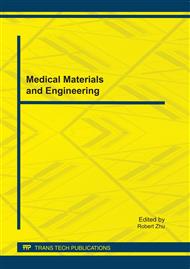[1]
M. Kalliomaki, S. Salminen, H. Arvilommi, P. Kero, P. Koskinen, and E.Isolauri, Probiotics in primary prevention of atopic disease: a randomised placebo-controlled trial. Lancet. 357(2001)1076–1079.
DOI: 10.1016/s0140-6736(00)04259-8
Google Scholar
[2]
J.M. Saavedra, N. A. Bauman, I. Oung, J. A. Perman, and R. H. Yolken. Feeding of Bifidobacterium bifidum and Streptococcus thermophilus to infants in hospital for prevention of diarrhoea and shedding of rotavirus. Lancet. 344(1994)1046–1049.
DOI: 10.1016/s0140-6736(94)91708-6
Google Scholar
[3]
J. Matto, H.L. Alakomi, A.Vaari, K.Virkajarvi, and M.Saarela. Influence of processing conditions on Bifidobacterium animalis subsp lactis functionality with a special focus on acid tolerance and factors affecting it. Int Dairy J.16(2006)1029–1037.
DOI: 10.1016/j.idairyj.2005.10.014
Google Scholar
[4]
X.C. Meng, C. Stanton, G.F. Fitzgerald, C. Daly, R.P. Ross. Anhydrobiotics: The challenges of drying probiotic cultures. Food Chem.106 (2008)1406–1416
DOI: 10.1016/j.foodchem.2007.04.076
Google Scholar
[5]
R.J. Heckly, Principles of preserving bacteria by freeze-drying, Developments in Industrial Microbiol .26(1985)379–395.
Google Scholar
[6]
C.P. Champagne, N.J. Gardner, and D.Roy. Challenges in the addition of probiotic cultures to foods. Crit Rev Food Sci.45(2005)61–84.
Google Scholar
[7]
S.B. Leslie, E.Israeli, B. Lighthart, J.H. Crowe. and L.M. Crowe Trehalose and sucrose protect both membranes and proteins in intact bacteria during drying. Appl Environ Microb. 61(1995)3592–3597.
DOI: 10.1128/aem.61.10.3592-3597.1995
Google Scholar
[8]
G.Zhao, and G.Zhang. Effect of protective agents, freezing temperature, rehydration media on viability of malolactic bacteria subjected to freeze-drying. J Appl Microbiol. 99(2005)333–338.
DOI: 10.1111/j.1365-2672.2005.02587.x
Google Scholar
[9]
Z. Hubalek, Protectants used in the cryopreservation of microorganisms. Cryobiol46(2005)205–229.
Google Scholar
[10]
B.M. Corcoran, R.P. Ross , G.F. Fitzgerald ,C.Stanton, Comparative survival of probiotic lactobacilli spray-dried in the presence of probiotic substances, J. Appl. Microbiol. 96 (2004) 1024–1039.
DOI: 10.1111/j.1365-2672.2004.02219.x
Google Scholar
[11]
M.Saarela, I.Virkajarvi, H.L. Alakomi, T.Mattila-Sandholm, A.Vaari, T.Suomalainen and J. Matto. Influence of fermentation time, cryoprotectant and neutralization of cell concentrate on freeze-drying survival, storage stability, and acid and bile exposure of Bifidobacterium animalis ssp lactis cells produced without milk-based ingredients. J. Appl .Microbiol. 99(2005) 1330–1339.
DOI: 10.1111/j.1365-2672.2005.02742.x
Google Scholar
[12]
M.C. Otero, M.C. Espeche and M.E. Nader-Macias. Optimization of the freeze-drying media and survival throughout storage of freeze-dried Lactobacillus gasseri and Lactobacillus delbrueckii subsp delbrueckii for veterinarian probiotic applications. Process Biochem.42(2007)1406–1411.
DOI: 10.1016/j.procbio.2007.07.008
Google Scholar
[13]
Z.Hubalek, Protectants used in the cryopreservation of microorganisms. Cryobiol.46(2003)205–229.
Google Scholar
[14]
C.A. Morgan, N.Herman, P.A. White and G.Vesey. Preservation of Microorganisms by Drying; A Review. J . Microbiol Meth. 66 (2006) 183-193.
Google Scholar
[15]
Q.Q Li, Q.H Chen, H.Ruan, D.S. Zhu, G.Q. He. Isolataion and characterization of an oxygen, acid and bile resistant Bifidobacterium animalis subsp.lactis Qq08.J . Sci. Food and Agri.90(2010)1340-1346
DOI: 10.1002/jsfa.3942
Google Scholar


